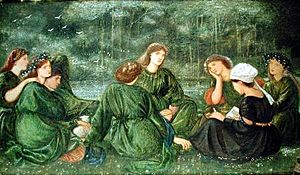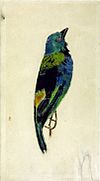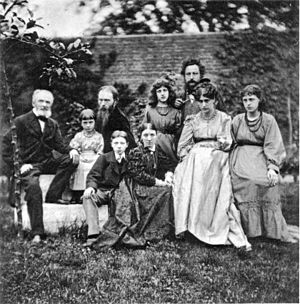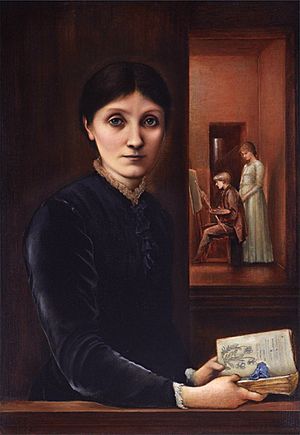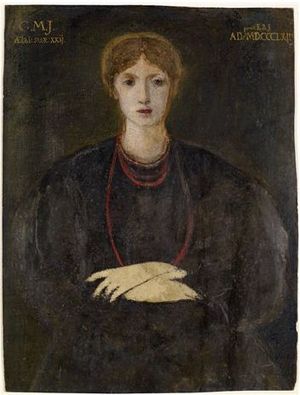Georgiana Burne-Jones facts for kids
Quick facts for kids
Georgiana Burne-Jones
|
|
|---|---|
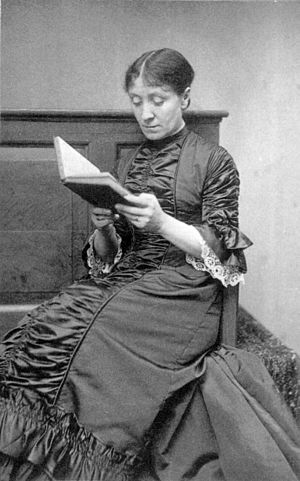
Georgiana Burne-Jones, née MacDonald c.1882, photographed by Frederick Hollyer
|
|
| Born |
Georgiana MacDonald
21 July 1840 |
| Died | 2 February 1920 (aged 79) |
| Nationality | British |
| Movement | Pre-Raphaelite Brotherhood, Aesthetic Movement, Arts and Crafts Movement |
| Spouse(s) | |
Georgiana, Lady Burne-Jones (born July 21, 1840 – died February 2, 1920) was a talented painter and engraver from England. She was the second oldest of the famous MacDonald sisters. Georgiana married Edward Burne-Jones, a well-known artist from the Pre-Raphaelite Brotherhood.
She was also the mother of painter Philip Burne-Jones. Her family was quite famous: she was the aunt of writer Rudyard Kipling and Prime Minister Stanley Baldwin. Georgiana was a close friend to many important people like George Eliot, William Morris, and John Ruskin. She helped manage the South London Gallery and was elected to her local council in Rottingdean. Georgiana is best known for writing a book about her husband's life, called The Memorials of Edward Burne-Jones. She also helped publish his beautiful Flower Book.
Contents
Growing Up in Birmingham
Georgiana, often called "Georgie," was born in Birmingham on July 21, 1840. She was one of eight children of Reverend George Browne Macdonald, a Methodist minister. Her family moved often because her father's church assignments usually lasted three years.
In 1850, her family returned to Birmingham. Her older brother, Harry, went to King Edward's School. Through him, Georgiana and her sisters met a group of students from University of Oxford. This group was known as the "Birmingham Set." Among them was a young man named Edward Jones, who later became Edward Burne-Jones.
Edward went to Exeter College at Oxford to study religion. There, he met William Morris because they both loved poetry. Edward and William, along with other friends, formed a close group called "The Brotherhood." They enjoyed reading books by John Ruskin and Tennyson. They also loved visiting old churches and were fascinated by the Middle Ages.
At first, Edward and William didn't know Dante Gabriel Rossetti. But they admired his art. They later met him when they asked him to write for their magazine, Oxford and Cambridge Magazine. This magazine was started by William Morris in 1856 to share their ideas. Because of Rossetti's influence, both Edward and William decided to become artists. Edward even left college early to start his art career.
In 1853, Georgiana's sister Carrie died from tuberculosis. After this, Georgiana's family moved to London. They lived in different places before settling in Marylebone in 1856. Georgiana became engaged to Edward in June 1856 when she was 15. This allowed her to visit the studio where Edward worked with Rossetti and Morris. She also met John Ruskin.
Georgiana felt deeply inspired by these artists. She said, "I felt in the presence of a new religion." In April 1860, artist Ford Madox Brown and his wife invited Georgiana to stay with them in London. This allowed her to spend more time with Edward. They married two months later.
Marriage and Family Life
Georgiana and Edward married in Manchester on June 9, 1860. Georgiana was 19, and Edward was 27. They had been engaged for exactly four years. They didn't have much money, but they were happy. Georgiana remembered thinking it was normal to ask their maid to pose for her drawings.
After their wedding, Georgiana and Edward moved into rented rooms in Great Russell Street. Their early marriage years were very happy. They spent a summer with William and Jane Morris at Red House. They all worked together on decorating the house.
Their first child, Philip, was born on October 21, 1861. But in the summer of 1864, little Phil caught scarlet fever. Georgiana also got very sick, which caused her second child, Christopher, to be born too early. Christopher was also infected and died soon after. Georgiana was ill for many months. When she recovered, she refused to go back to their old rooms because of the sadness there.
The family soon moved to 41 Kensington Square. Their daughter Margaret was born there in the summer of 1866. After Georgiana's marriage, her sisters also married. Louisa married Alfred Baldwin, Alice married John Lockwood Kipling, and Agnes married Edward Poynter. Their youngest sister, Edith, stayed home to care for their parents.
Georgiana's Artistic Work
Georgiana attended the Government School of Design. This school was part of the South Kensington museums, now known as the Victoria and Albert Museum. However, Georgiana felt she didn't learn much important there.
In 1856, Georgiana took lessons from Ford Madox Brown. She remembered his kindness in letting her and a friend paint from a model in his studio.
Not many of Georgiana's artworks still exist today. We have one of her woodcuts and a small, beautiful watercolor of a dead bird. These show her focus on small, detailed drawings and woodcuts. She often made these for book illustrations. The bird painting was done in 1857 and is now kept at the Tate Britain museum.
In 1861, a company called Morris, Marshall, Faulkner & Co. was started. It was created by William Morris, Madox Brown, Edward Burne-Jones, and others. They made handcrafted items for homes, inspired by medieval times. Georgiana was hired to paint tiles for the company. But when her son Philip was born in October that year, she stopped working in the art studio. She chose to become a full-time caregiver for her child. She felt a bit sad hearing her friends and Edward laughing in the studio while she was with her baby. By 1868, she was still trying to learn etching, but none of her etched works were published.
Important Friendships
In 1867, the Burne-Jones family moved again. They went to The Grange, an old house with a big garden in Fulham, London. For much of the 1870s, Edward Burne-Jones did not show his art. This was partly because of harsh criticism from the press. During these challenging years, Georgiana became very close friends with William Morris.
Georgiana and William Morris remained close until his death. Georgiana wrote to her friend Rosalind Howard, saying that she believed there was enough love between her and Edward to last a long life. In the end, the Burne-Joneses stayed together for another 30 years.
Another close friend was George Eliot, a famous writer. Georgiana met her in February 1868. George Eliot encouraged Georgiana to improve her education. Georgiana studied to get better at French and German, and she took Latin lessons. They stayed close friends until George Eliot's sudden marriage in 1880. Georgiana felt surprised and a bit hurt because she didn't know about it beforehand. Sadly, their friendship never fully recovered, as George Eliot died that December.
In Public Service

In 1880, the Burne-Joneses bought Prospect House in Rottingdean, near Brighton in Sussex. This was their holiday home. In 1889, they bought the house next door and combined them to create North End House. Georgiana loved her new country home and garden. She became very involved in village life. Rottingdean felt more like home to her than it did to her husband.
Even though she had left organized religion when she married, Georgiana's Methodist upbringing taught her to serve her community. She supported William Morris's active role in social causes. Her close friends, like Morris, John Ruskin, and Rosalind Howard, were all involved in helping society.
Georgiana's first steps into public service were supporting the South London Fine Art Gallery. This gallery was started in 1891 to provide art education for working-class people in South London. Georgiana helped arrange for her husband's paintings and others' to be shown there. She and Walter Crane also pushed for a library to be added to the gallery. She became the only woman on the committee that managed the gallery. Here, she discovered she was good at detailed committee work.
In the mid-1880s, Edward Burne-Jones started adding a hyphen to his name. He did this to stand out from all the other "Joneses." So, Georgiana became Lady Burne-Jones when her husband accepted a special title called a baronet in 1894. He accepted it partly because the title would pass to their son Philip, who enjoyed high society.
In 1895, Lady Burne-Jones took her first steps into elected office. She won a seat on the parish council of Rottingdean. This made both her husband and William Morris happy. She supported the interests of working-class people and women's issues. Her ideas were quite new for the wife of a baronet. But her daily work on the council focused on practical things like street lighting, fire brigades, and getting a village nurse for the community.
Later Life and Legacy
William Morris died in October 1896 after a long illness. Edward Burne-Jones was very sad, as Morris had been his friend and partner since college. Edward's health got much worse. In 1898, he had the flu and seemed to recover. But then he suddenly became ill again and died of a heart attack on June 17, 1898. Six days later, a special memorial service was held for him at Westminster Abbey. This was the first time an artist had been honored in such a way. Edward Burne-Jones was cremated, and his ashes were buried in a grave lined with moss and roses at the village church in Rottingdean.
Edward Burne-Jones had worried that someone who didn't understand him would write his life story. He asked his wife, Georgiana, to do it. Georgiana, who was 58, started working on the book within months of Edward's death. She enjoyed remembering their life together. She wrote, "There are so few left now who can recall those early days when Gabriel [Rossetti] was in his glory and Edward and Morris sat at his feet and rejoiced in his light."
Her book, Memorials of Edward Burne-Jones, was published six years later in 1904. It came out in two volumes and is still an important source of information today. As was common at the time, some personal details were not included in the book.
While working on the Memorials, Georgiana stayed active on the Rottingdean parish council. Her political views became even stronger as she got older. When the Boer War started, many people in England supported the war. But Georgiana was against Britain's actions in South Africa. When news arrived that the siege of Mafeking was over, Georgiana hung a banner at her house. It read, "We have killed and also take possession," which was a quote from the Bible. Her nephew, Rudyard Kipling, rushed to her house to make sure she was safe from angry villagers.
In 1905, Georgiana arranged for The Flower Book to be published. This was a special limited edition of Edward Burne-Jones's watercolor flower paintings. Three hundred copies were made with the Fine Art Society of London. The book was printed using a special technique that made the colors very bright.
Georgiana Burne-Jones died on February 2, 1920, after a short illness. Her son Philip, who became a portrait painter, died in 1926. Her daughter Margaret married John William Mackail, a friend and biographer of William Morris. Margaret died in 1953. Her children included the famous writers Angela Thirkell and Denis Mackail.
In Portraits
Georgiana Burne-Jones was painted and drawn by her husband and other artists many times. A portrait by her husband from 1863 shows Georgiana at 22 years old. This painting, now in the Birmingham Museum and Art Gallery, looks like old Renaissance portraits. It was one of Edward Burne-Jones's first formal portraits.
Green Summer, a watercolor by Edward Burne-Jones from 1864, shows Georgiana reading aloud. Her sisters Louisa and Agnes, and Jane Morris, are listening in the garden at Red House. An oil painting version of this scene was made in 1868.
Her brother-in-law, the artist Edward Poynter, painted a portrait of Georgiana drinking tea around 1870.
Edward Burne-Jones started his most famous portrait of his wife in 1883. It shows her holding a book about plants, with their children in the background. Philip (around 22) is at his easel, and Margaret (around 17) is standing behind him. Edward worked on this portrait for years, but it was not finished when he died. It was never shown to the public during his lifetime.



